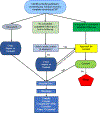The NHLBI Study on Long-terM OUtcomes after the Multisystem Inflammatory Syndrome In Children (MUSIC): Design and Objectives
- PMID: 34418362
- PMCID: PMC8710361
- DOI: 10.1016/j.ahj.2021.08.003
The NHLBI Study on Long-terM OUtcomes after the Multisystem Inflammatory Syndrome In Children (MUSIC): Design and Objectives
Abstract
Background: The Long-terM OUtcomes after the Multisystem Inflammatory Syndrome In Children (MUSIC) study aims to characterize the frequency and time course of acute and long-term cardiac and non-cardiac sequelae in multisystem inflammatory syndrome in children associated with COVID-19 (MIS-C), which are currently poorly understood.
Methods: This multicenter observational cohort study will enroll at least 600 patients <21 years old who meet the Centers for Disease Control and Prevention case definition of MIS-C across multiple North American centers over 2 years. The study will collect detailed hospital and follow-up data for up to 5 years, and optional genetic testing. Cardiac imaging at specific time points includes standardized echocardiographic assessment (all participants) and cardiac magnetic resonance imaging (CMR) in those with left ventricular ejection fraction (LVEF) <45% during the acute illness. The primary outcomes are the worst LVEF and the highest coronary artery z-score of the left anterior descending or right coronary artery. Other outcomes include occurrence and course of non-cardiac organ dysfunction, inflammation, and major medical events. Independent adjudication of cases will classify participants as definite, possible, or not MIS-C. Analysis of the outcomes will include descriptive statistics and regression analysis with stratification by definite or possible MIS-C. The MUSIC study will provide phenotypic data to support basic and translational research studies.
Conclusion: The MUSIC study, with the largest cohort of MIS-C patients and the longest follow-up period to date, will make an important contribution to our understanding of the acute cardiac and non-cardiac manifestations of MIS-C and the long-term effects of this public health emergency.
Copyright © 2021 Elsevier Inc. All rights reserved.
Figures
References
-
- WHO Health Emergency Dasboard. In: https://covid19whoint/; Access date: June 10, 2021.
-
- CDC COVID Data Tracker. In: https://covidcdcgov/covid-data-tracker/#demographics; Access Date: March 23, 2021.
-
- CDC Health Advisory: Multi-system Inflammatory Syndrome in Children (MIS-C) Associated with Coronavirus Disease 2019 (COVID-19). In; 2020.
Publication types
MeSH terms
Supplementary concepts
Grants and funding
- UG1 HL135665/HL/NHLBI NIH HHS/United States
- UG1 HL135666/HL/NHLBI NIH HHS/United States
- UG1 HL135646/HL/NHLBI NIH HHS/United States
- UG1 HL135683/HL/NHLBI NIH HHS/United States
- UG1 HL135685/HL/NHLBI NIH HHS/United States
- UG1 HL135689/HL/NHLBI NIH HHS/United States
- U10 HL068270/HL/NHLBI NIH HHS/United States
- U01 HL068270/HL/NHLBI NIH HHS/United States
- UG1 HL135678/HL/NHLBI NIH HHS/United States
- P50 HD105351/HD/NICHD NIH HHS/United States
- UG1 HL135680/HL/NHLBI NIH HHS/United States
- U24 HL135691/HL/NHLBI NIH HHS/United States
- UG1 HL135682/HL/NHLBI NIH HHS/United States
LinkOut - more resources
Full Text Sources
Medical
Molecular Biology Databases


